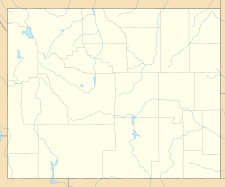Knife Point Glacier facts for kids
Quick facts for kids Knife Point Glacier |
|
|---|---|
| Type | Mountain glacier |
| Coordinates | 43°06′41″N 109°34′39″W / 43.11139°N 109.57750°W |
| Length | .9 mi (1.4 km) |
| Terminus | Talus |
| Status | Retreating |
Knife Point Glacier is a large river of ice found in the Wind River Range in Wyoming, USA. It sits on the eastern side of the Continental Divide of the Americas. This divide is like a big mountain ridge that separates rivers flowing to different oceans. The glacier is part of the Fitzpatrick Wilderness within the Shoshone National Forest.
Knife Point Glacier is one of many glaciers in the American Rocky Mountains. It flows towards the north. The glacier starts just below the top of Knife Point Mountain, which is a very tall peak.
Contents
What is Knife Point Glacier?
A glacier is a huge, slow-moving river of ice. Knife Point Glacier is a type of mountain glacier. It is nearly 1 kilometer (0.9 miles) long. This glacier is a natural wonder, showing how ice can shape the land over many years.
Where is Knife Point Glacier Located?
Knife Point Glacier is found in Fremont County, Wyoming. It is high up in the northern part of the Wind River Range. This area is known for its rugged mountains and beautiful wilderness. The glacier is protected within the Shoshone National Forest. It is also part of the Fitzpatrick Wilderness, a special area where nature is preserved.
Why is Knife Point Glacier Important?
Like many glaciers around the world, Knife Point Glacier has been getting smaller. This change has revealed some surprising things. Scientists can learn a lot by studying how glaciers change.
The Retreat of the Glacier
Since about 1850, Knife Point Glacier has been melting and shrinking. This process is called "retreating." The year 1850 marks the end of a period known as the Little Ice Age. During that time, many glaciers were much larger. The rapid retreat of Knife Point Glacier shows us how much the climate has changed.
The Rocky Mountain Locust Mystery
As Knife Point Glacier has melted, it has uncovered something very interesting. The remains of many Rocky Mountain locusts have been found. These locusts (Melanoplus spretus) were a type of grasshopper. They used to live in huge swarms across parts of North America.
Scientists believe the Rocky Mountain locust is now extinct. Finding their remains in the ice helps researchers learn more about these insects. It also helps them understand past environments and how creatures lived long ago.


